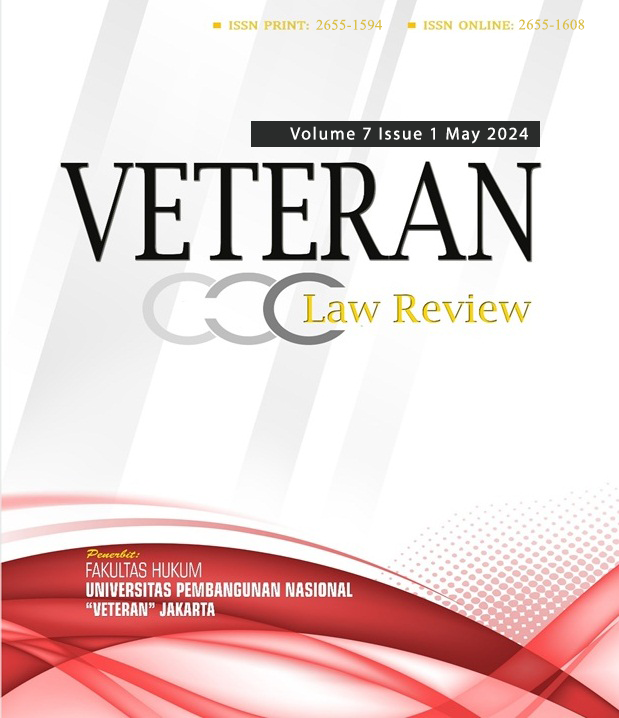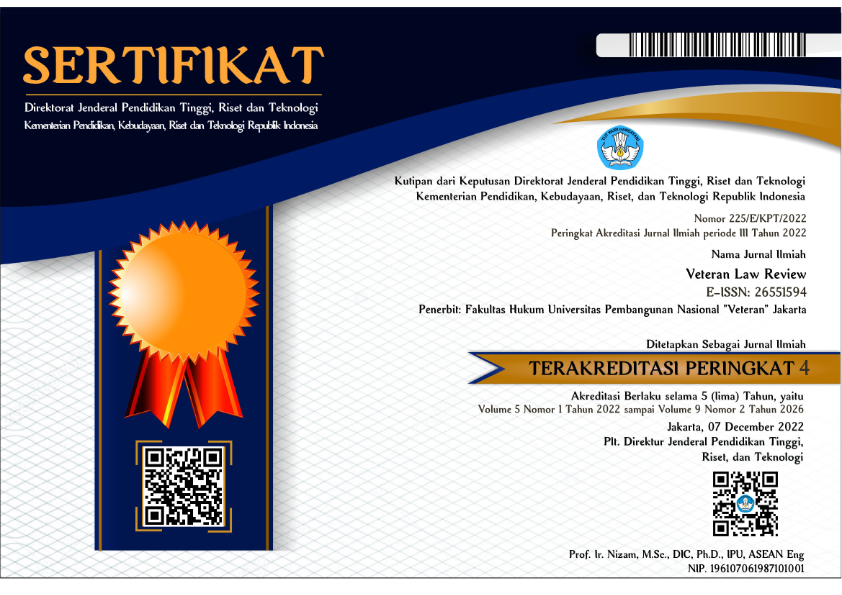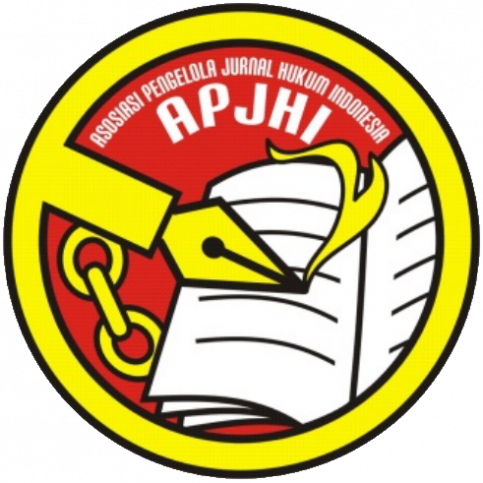Removing Bodies from the Grave from the Perspective of National Criminal Law and Islamic Law
DOI:
https://doi.org/10.35586/velrev.v7i1.7523Keywords:
IUUF; Criminal Law Regulation, Removal, CorpseAbstract
Corpse removal is the process of moving the body of a person from one place to another. Sometimes, this is done at the request of the family, for cultural or religious reasons, or even for other reasons such as demolition of the burial site or redevelopment of the burial area. The purpose of this research is to find out the rule of law to answer the issue of grave transfer.
This type of research is normative juridical research obtained from secondary data related to the object of research including related laws and court decisions. In this research, data analysis is carried out qualitatively, namely the selection of theories, principles, norms, doctrines and articles contained in the Law that are relevant to this research.
Based on the results of the research, the criminal act of corpse removal has criminal law rules, namely in Article 180 of Law No. 1 of 1946 concerning the Criminal Code and in Article 271 of Law No. 1 of 2023 concerning the Criminal Code. The removal of corpses from the grave is also not justified by several Islamic scholars so that this is in line with criminal law. In the case that occurred in Donggala district based on the Donggala District Court Decision No. reg 11/Pid.B/2014/PN.Dgl the Panel of Judges sentenced the defendants to imprisonment for four months each
Downloads
References
Ali, Zainuddin. (2009). “Hukum Pidana Islam” Jakarta: Sinar Grafika
Astuti, Widya., Ishaq., dan Kurniawan, Edi. (2020). “Pertanggungjawaban Pidana Terhadap Doen Pleger dan Dader Menurut Hukum Pidana Islam dan Kitab Undang-Undang Hukum Pidana (KUHP)" Jurnal Islamic Law and Studies 4(1):49-60
Fajar, Mukti., dan Achmad, Yuliyanto. (2013) “Dualisme Penelitian Hukum: Normatif & Empiris”, Yogyakarta: Pustaka Pelajar.
Hamdi, Syaibatul., dan Efendi, Sumardi. (2022). “Konsep keadilan Delik Pembunuhan Dalam Hukum Positif Indonesia dan Hukum Islam” Maqasidi: Jurnal Syariah dan Hukum 2(2):144-159
Hanafi. (2019). “Landasan Filosofis Kebijakan Formulasi Kejahatan Terhadap Jenazah dalam Pasal 180 KUHP” Jurnal Voice Justisia: Jurnal Hukum dan Keadilan 3(1):73-96
Hanifah, Ida, Ismail Koto. (2021). “Problema Hukum Seputar Tunjangan Hari Raya Di Masa Pandemi COVID-19”, Jurnal Yuridis 8 No. 1.
Irmawanti, Noveria Devy., dan Arief, Barda Nawawi. (2021) “Urgensi Tujuan dan Pedoman Pemindanaan Dalam Rangka Pembaruan Sistem Pemidanaan Hukum Pidana” Jurnal Pembangunan Hukum Indonesia 3(2):217-227
Ishaq, (2020). “Hukum Pidana. Depok”: PT Raja Grafindo Persada.
Koto, Ismail. (2021). “Perlindungan Hukum Terhadap Korban Tindak Pidana Terorisme”, Proceding Seminar Nasional Kewirausahaan, 2 No. 1.
Mufid, Achmad. (2017). "Risalah Kematian, Merawat Jenazah", Jakarta: PT Total Media.
Muliyadi, Lilik. (2012). “Bunga Rampai Hukum Pidana Umum dan Khusus”, Bandung, Alumni.
Pramono, Sugeng. (2008). “Pembongkaran Makam dan Pemindahan Kerangka Jenazah Menurut Prespektif Hukum Islam” (Skripsi). Program studi pembandingan mahzab dan hukum, Jakarta.
Pratiwi, Siswantari. (2022). “Delik Penyertaan Dalam Kitab Undang-Undang Hukum Pidana (KUHP)" Binamulia Hukum 11(1):69-80
Rafli, Muhammad. (2023). “Etika Profesi Hakim Dalam Melaksanakan Tugas dan Tanggung Jawab dalam Penegakan Hukum” Madani: Jurnal Ilmiah Multidisiplin 1(11):342-349
Rijal, B, M. (2020). “Sanksi Pidana Pembunuhan Dalam Kitab Undang-Undang Hukum Pidana Dengan Hukum Islam” Jurnal Al- Ishlah; Jurnal Ilmiah Hukum 23:1-38
Sabatian, Dwi Adona. (2017). “Tinjauan Yurisis, kriminologis, dan Empiris kasus Pencurian mayat di Purbalingga dan Cilacap” Jurnal Jurisprudence 4(1):45-51
Salle. 2020. "Sistem Hukum Dan Penegakan Hukum". Makassar: CV. Sosial Politic Genius.
Peraturan Undang-Undang:
Undang-Undang Dasar negara Republik Indonesia
Undang-Undang No.1 Tahun 1946 tentang Kitab Undang-Undang Hukum Pidana
Undang-Undang No.1 Tahun 2023 tentang Kitab Undang-Undang Hukum Pidana
Downloads
Published
How to Cite
Issue
Section
License
Copyright (c) 2024 Veteran Law Review

This work is licensed under a Creative Commons Attribution-ShareAlike 4.0 International License.
Copyright (c) 2022 Veteran Law Review Journal
Veteran Law Review © 2022 by Faculty of Law Universitas Pembangunan Nasional "Veteran" Jakarta is licensed under Creative Commons Attribution 4.0 International

1. License
The non-commercial use of the article will be governed by the Creative Commons Attribution license as currently displayed on Creative Commons Attribution 4.0 International.
2. Author(s)' Warranties
The author warrants that the article is original, written by the stated author(s), has not been published before, contains no unlawful statements, does not infringe the rights of others, is subject to copyright that is vested exclusively in the author, and free of any third party rights, and that any necessary written permissions to quote from other sources have been obtained by the author(s).
3. User/Public Rights
VELREV's spirit is to disseminate articles published are as free as possible. Under the Creative Commons Attribution-ShareAlike 4.0 International License. VELREV permits users to copy, distribute, display, and perform the work for non-commercial purposes only. Users will also need to attribute authors and VELREV to distributing works in the journal and other media of publications.
4. Rights of Authors
Authors retain all their rights to the published works, such as (but not limited to) the following rights;
- Reproduce the work
- Prepare derivative works based upon the work
- Distribute copies of the work
- Perform the work publicly
- Display the work publicly
- Copyright and other proprietary rights relating to the article, such as patent rights,
- The right to self-archive the article,
- The right to enter into separate, additional contractual arrangements for the non-exclusive distribution of the article's published version (e.g., post it to an institutional repository or publish it in a book), with an acknowledgement of its initial publication in this journal (Veteran Law Review).
5. Co-Authorship
If the article was jointly prepared by more than one author, any author submitting the manuscript warrants that he/she has been authorized by all co-authors to be agreed on this copyright and license notice (agreement) on their behalf, and agrees to inform his/her co-authors of the terms of this policy. VELREV will not be held liable for anything that may arise due to the author's internal dispute. VELREV will only communicate with the corresponding author.
6. Royalties
Being an open accessed journal and disseminating articles for free under the Creative Commons license term mentioned, author(s) are aware that VELREV entitles the author(s) to no royalties or other fees.
7. Miscellaneous
VELREV will publish the article (or have it published) in the journal if the article’s editorial process is successfully completed. JOSI's editors may modify the article to a style of punctuation, spelling, capitalization, referencing, and usage that deems appropriate. The author acknowledges that the article may be published so that it will be publicly accessible and such access will be free of charge for the readers as mentioned in point 3.


















